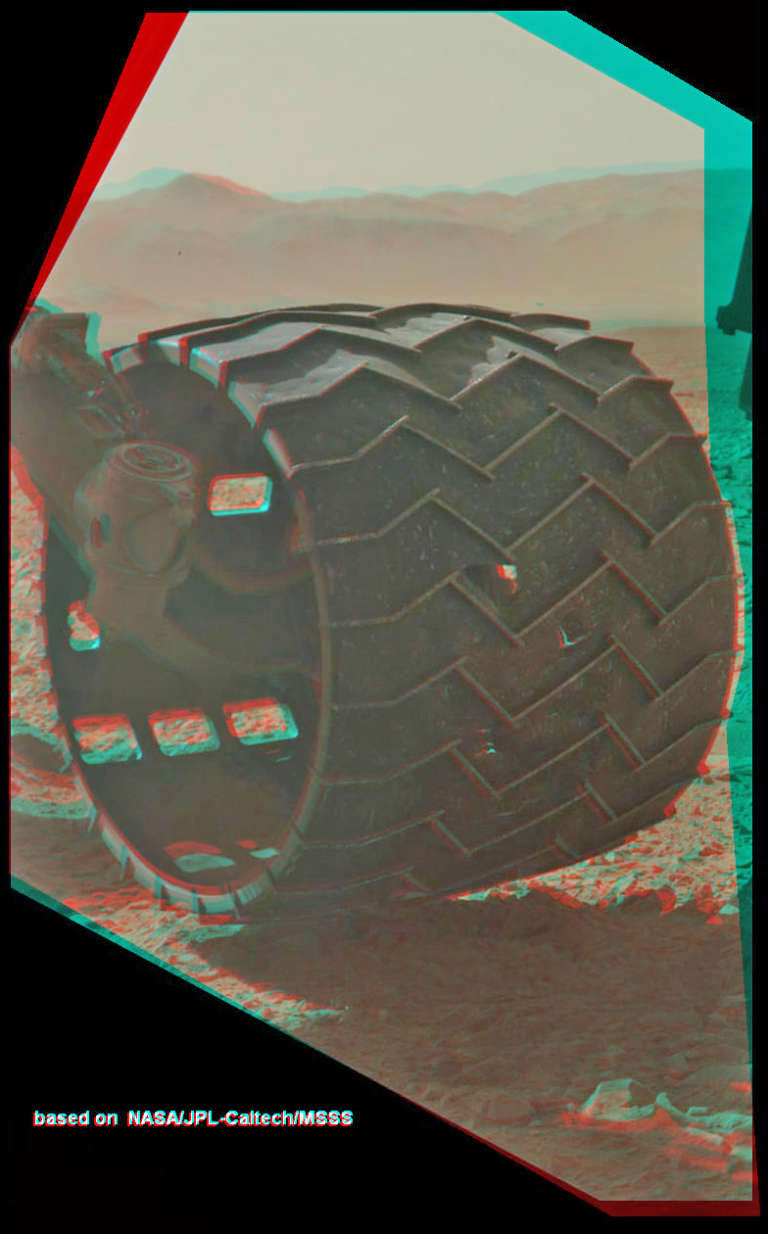Ken Herkenhoff • Nov 25, 2013
Curiosity update, sols 453-464: Electrical problem causes delays; rover back to work
Editor's note: This blog is reposted with permission from the United States Geological Survey Astrogeology Science Center website. Images have been added by me. My favorite place to browse these images is midnightplanets.com. My favorite place to follow the rover's driving progress is curiositylog.com. Read this for an introduction to Herkenhoff's blog posts. --ESL
Sol 453: Deja Vu (14 November 2013)
I was SOWG Chair again planning Sol 452, which was disappointing because it was basically a repeat of Sol 451. When the Sol 451 plan was run on the testbed, a potential problem was discovered and the decision was made at the last minute not to send it to the rover. The problem, which may have caused the rover to reboot, was corrected in the Sol 452 plan. The recovery from the software anomaly has been completed and the Sol 453 plan included targeted remote sensing and a drive. The drive went well (~47 meters) and another drive is being planned for Sol 454.
Sol 458: Murray Buttes (18 November 2013)
The plan for last weekend included driving on 2 sols. Unfortunately, the first drive, on Sol 455, was aborted due to a wheel stall. There was also an electrical problem, so the Sol 458 plan will be devoted to getting the engineering data needed to recover from this problem. The rover is in a stable configuration but no science activities will be planned until tomorrow.
I was happy to see the announcement that features on Mars have been named in honor of Bruce Murray, former JPL director and my thesis adviser at Caltech in the 1980s. I can't wait to see what "Murray Buttes" look like up close when MSL gets there! It's too bad Bruce won't get to see the pictures of these features--he would have loved them!

Sol 460: Stand Down (19 November 2013)
I was scheduled as MAHLI/MARDI uplink lead today, but there was nothing to do because all science planning is on hold while the power issue is being investigated. Because planning is restricted this week, diagnostic data acquired today will not be available in time for planning tomorrow. If the diagnostics go well, we may be able to plan scientific observations as early as Thursday, for Sol 461.
Jet Propulsion Laboratory Press Release: Rover Team Working to Diagnose Electrical Issue (20 November 2013)
Science observations by NASA's Mars rover Curiosity have been suspended for a few days while engineers run tests to check possible causes of a voltage change detected on Nov. 17.
"The vehicle is safe and stable, fully capable of operating in its present condition, but we are taking the precaution of investigating what may be a soft short," said Mars Science Laboratory Project Manager Jim Erickson at NASA's Jet Propulsion Laboratory, Pasadena, Calif.
A "soft" short is a leak through something that's partially conductive of electricity, rather than a hard short such as one electrical wire contacting another.
The team detected a change in the voltage difference between the chassis and the 32-volt power bus that distributes electricity to systems throughout the rover. Data indicating the change were received on Sunday, during Curiosity's 456th Martian day. The level had been about 11 volts since landing day, and is now about 4 volts. The rover's electrical system is designed with the flexibility to work properly throughout that range and more -- a design feature called "floating bus."
A soft short can cause such a voltage change. Curiosity had already experienced one soft short on landing day in August 2012. That one was related to explosive-release devices used for deployments shortly before and after the landing. It lowered the bus-to-chassis voltage from about 16 volts to about 11 volts but has not affected subsequent rover operations.
Soft shorts reduce the level of robustness for tolerating other shorts in the future, and they can indicate a possible problem in whichever component is the site of the short. Operations planned for Curiosity for the next few days are designed to check some of the possible root causes for the voltage change. Analysis so far has determined that the change appeared intermittently three times during the hours before it became persistent.
The electrical issue did not cause the rover to enter a safe-mode status, in which most activities automatically cease pending further instructions, and there is no indication the issue is related to a computer reboot that triggered a "safe-mode" earlier this month.
Sol 461: Electrical Issue (20 November 2013)
There will be no MSL science planning again today, as analysis of the recent electrical issue continues. We are hope to return to normal science operations on Friday, planning 3 sols for the weekend.
Sol 462-464: Planning Resumed (22 November 2013)
MSL science planning has resumed! Today we are planning 3 sols, with the focus on dropping more of the drill sample into 4 of SAM's cups, for future analysis. While the arm is out, we'll take MAHLI images of the rover wheels and a Mastcam image of the sample seive, for engineering assessment. These arm activities will take 2 sols to complete, so the plan is pretty full. I'm scheduled to support ChemCam planning in the Science Theme Groups today, but because the plan is already so complex we couldn't add any ChemCam observations. Still, it's good to be planning science activities again!

Jet Propulsion Laboratory Press Release: Curiosity Resumes Science After Analysis of Voltage Issue (25 November 2013)
NASA's Mars rover Curiosity resumed full science operations on Saturday, Nov. 23.
Activities over the weekend included use of Curiosity's robotic arm to deliver portions of powdered rock to a laboratory inside the rover. The powder has been stored in the arm since the rover collected it by drilling into the target rock "Cumberland" six months ago. Several portions of the powder have already been analyzed. The laboratory has flexibility for examining duplicate samples in different ways.
The decision to resume science activities resulted from the success of work to diagnose the likely root cause of a Nov. 17 change in voltage on the vehicle. The voltage change itself did not affect the rover safety or health. The vehicle's electrical system has a "floating bus" design feature to tolerate a range of voltage differences between the vehicle's chassis -- its mechanical frame -- and the 32-volt power lines that deliver electricity throughout the rover. This protects the rover from electrical shorts.
"We made a list of potential causes, and then determined which we could cross off the list, one by one," said rover electrical engineer Rob Zimmerman of NASA's Jet Propulsion Laboratory, Pasadena, Calif. Science operations were suspended for six days while this analysis took priority.
The likely cause is an internal short in Curiosity's power source, the Multi-Mission Radioisotope Thermoelectric Generator. Due to resiliency in design, this short does not affect operation of the power source or the rover. Similar generators on other spacecraft, including NASA's Cassini at Saturn, have experienced shorts with no loss of capability. Testing of another Multi-Mission Radioisotope Thermoelectric Generator over many years found no loss of capability in the presence of these types of internal shorts.
Following the decision to resume science activities, engineers learned early Nov. 23 that the rover had returned to its pre-Nov. 17 voltage level. This reversal is consistent with their diagnosis of an internal short in the generator on Nov. 17, and the voltage could change again.
The analysis work to determine the cause of the voltage change gained an advantage from an automated response by the rover's onboard software when it detected the voltage change on Nov. 17. The rover stepped up the rate at which it recorded electrical variables, to eight times per second from the usual once per minute, and transmitted that engineering data in its next communication with Earth. "That data was quite helpful," Zimmerman said.
In subsequent days, the rover performed diagnostic activities commanded by the team, such as powering on some backup hardware to rule out the possibility of short circuits in certain sensors.
The Time is Now.
As a Planetary Defender, you’re part of our mission to decrease the risk of Earth being hit by an asteroid or comet.
Donate Today

 Explore Worlds
Explore Worlds Find Life
Find Life Defend Earth
Defend Earth


